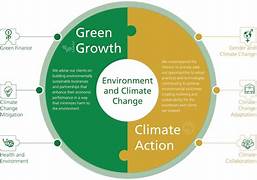Environmental Policy Initiatives and Their Implications on Global Climate Change
The issue of global climate change is one of the most pressing challenges facing humanity in the 21st century. The scientific consensus is clear: human activities, particularly the burning of fossil fuels, deforestation, and industrial processes, have contributed significantly to the accumulation of greenhouse gases in the atmosphere. These gases, primarily carbon dioxide (CO2), methane (CH4), and nitrous oxide (N2O), trap heat in the Earth’s atmosphere, leading to global warming and significant changes in climate patterns. As the consequences of climate change become more apparent, governments, businesses, and individuals around the world are recognizing the urgency of adopting effective environmental policy initiatives to mitigate its effects.
Environmental policy initiatives are designed to address a wide range of issues, including reducing greenhouse gas emissions, protecting ecosystems, transitioning to renewable energy, and promoting sustainable development. These policies can be implemented at local, national, and international levels, and they have the potential to drive meaningful change in the fight against climate change. In this article, we will explore the implications of environmental policy initiatives on global climate change, examining their successes, challenges, and long-term effects.
The Need for Environmental Policy Initiatives
The global climate crisis is characterized by rising temperatures, extreme weather events, melting ice caps, sea-level rise, and shifts in ecosystems. These phenomena pose significant risks to human health, food security, water availability, biodiversity, and economic stability. Without concerted efforts to reduce emissions and mitigate climate impacts, the world faces a future of increased poverty, displacement, and social unrest.
The role of environmental policy initiatives is to address these challenges by setting legal and regulatory frameworks that incentivize sustainable practices, regulate harmful activities, and promote innovative solutions. These policies can range from international agreements to national regulations, and their success depends on cooperation between governments, businesses, scientists, and individuals.
International Environmental Agreements and Their Implications
One of the most significant environmental policy initiatives in recent decades has been the development of international agreements aimed at addressing global climate change. The Paris Agreement, adopted in 2015 at the United Nations Framework Convention on Climate Change (UNFCCC) conference, is perhaps the most well-known example. Its goal is to limit global warming to well below 2 degrees Celsius, ideally aiming for 1.5 degrees Celsius, compared to pre-industrial levels.
The Paris Agreement: A Landmark in Climate Policy
The Paris Agreement has had a profound impact on global environmental policy. The agreement set a framework for countries to make nationally determined contributions (NDCs) to reduce greenhouse gas emissions and enhance climate resilience. One of its key features is the inclusion of all nations—developed and developing countries alike—in the commitment to combat climate change. The agreement also encourages regular reviews of progress and updates to ensure that targets are met and that the global community is moving toward the agreed-upon goal.
The implications of the Paris Agreement are far-reaching. By fostering international cooperation, the agreement has brought climate change to the forefront of global policy discussions. It has spurred governments to implement a range of policies to transition to low-carbon economies, promote renewable energy, and incentivize sustainable practices. Countries are increasingly focusing on integrating climate change mitigation and adaptation into their national development plans.
However, the Paris Agreement has also faced criticism for its non-binding nature. While it sets ambitious goals, it does not impose strict penalties on countries that fail to meet their targets. This has raised concerns about the adequacy of the agreement in addressing the urgency of climate change and the potential for non-compliant nations to continue emitting greenhouse gases without significant consequences.
The Role of Carbon Markets and Trade
Environmental policy initiatives at the international level have also included the creation of carbon markets, which allow countries and companies to trade carbon credits as a means of reducing emissions. These markets provide economic incentives for industries to reduce their carbon footprints by offering a financial return for emission reductions. Carbon markets, such as the European Union Emissions Trading Scheme (EU ETS), are designed to cap overall emissions while allowing flexibility in how reductions are achieved.
Carbon markets have played a role in driving down emissions in sectors such as energy, transportation, and manufacturing. However, their effectiveness has been debated, with concerns about over-allocation of credits, lack of transparency, and the challenge of ensuring that emissions reductions are meaningful. Despite these challenges, carbon pricing remains a critical tool in the broader effort to incentivize decarbonization and raise funds for climate adaptation and mitigation projects.
National and Local Environmental Policies
While international agreements are essential for addressing the global nature of climate change, national and local environmental policies play a critical role in implementing solutions on the ground. Countries around the world are adopting various strategies to reduce emissions, promote renewable energy, and transition to sustainable economies.
Renewable Energy Incentives
One of the most effective ways to combat climate change is to transition away from fossil fuels and towards renewable energy sources such as wind, solar, hydroelectric, and geothermal power. Governments are increasingly adopting policies that incentivize the development and deployment of renewable energy technologies. These incentives include subsidies, tax credits, and feed-in tariffs that encourage investment in renewable energy infrastructure and support the growth of the green energy sector.
In countries like Denmark, Germany, and China, renewable energy policies have led to significant growth in wind and solar power, contributing to a reduction in fossil fuel dependence. In the United States, the expansion of renewable energy has been supported through policies such as the Investment Tax Credit (ITC) and the Production Tax Credit (PTC), which have driven the growth of solar and wind industries.
Despite the progress, challenges remain. Renewable energy technologies are still often more expensive than fossil fuels, particularly in regions with limited access to renewable resources or where fossil fuel subsidies are entrenched. Additionally, renewable energy integration into existing energy grids presents technical challenges, particularly in regions with variable weather conditions.
Carbon Taxation and Emissions Regulations
Carbon taxation is another environmental policy tool that has been adopted by some countries to incentivize emissions reductions. By imposing a tax on carbon emissions, governments can encourage industries to reduce their carbon footprints by investing in cleaner technologies and energy efficiency measures. The revenue generated from carbon taxes can be used to fund climate change mitigation projects, such as reforestation, infrastructure development, and climate adaptation programs.
Countries such as Sweden and Canada have implemented carbon taxes with notable success, leading to reduced emissions in key sectors like transportation and energy. However, carbon taxes face resistance in many parts of the world, particularly in regions where the economy is heavily dependent on fossil fuel industries. The implementation of carbon taxes requires careful consideration of the social and economic impacts, particularly on vulnerable populations and sectors.
The Challenges of Implementing Effective Environmental Policies
While environmental policy initiatives have led to significant progress in addressing climate change, there are several challenges that must be overcome to achieve meaningful and lasting change.
Political Will and Global Cooperation
One of the key challenges in tackling climate change is the lack of political will in many countries. While some governments have committed to ambitious climate goals, others remain reluctant to take significant action due to political pressures, economic concerns, or vested interests in the fossil fuel industry. The lack of global cooperation, especially from major emitting nations, has hindered the effectiveness of international agreements like the Paris Agreement.
Equity and Fairness
Another challenge is ensuring that climate policies are equitable and fair. Climate change disproportionately affects developing countries, which often have fewer resources to adapt to its impacts. Environmental policies must consider the needs of vulnerable populations and provide financial and technical support to help them transition to low-carbon economies.
Technological Innovation and Infrastructure Development
Technological innovation is critical to addressing climate change, but many countries face challenges in developing and deploying clean technologies at scale. Investment in research and development, as well as infrastructure development, is necessary to enable a rapid transition to sustainable energy systems. However, the pace of innovation may not be fast enough to meet the targets set by international agreements.
Conclusion
Environmental policy initiatives have become central to the global effort to mitigate climate change and promote sustainability. International agreements such as the Paris Agreement, national renewable energy incentives, and local carbon taxes are all part of the larger strategy to reduce greenhouse gas emissions, protect ecosystems, and transition to a low-carbon economy. While these initiatives have led to significant progress, challenges remain in terms of political will, equity, and technological innovation. Ultimately, effective environmental policies require a collaborative, global effort to address the climate crisis and ensure a sustainable future for all.


